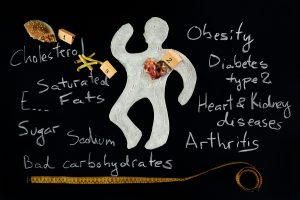 Why is the American diet (called SAD for Standard American Diet) the leading cause of death? The 2010 Global Burden of Disease Study, funded by the Bill and Melinda Gates Foundation, determined the leading cause of death and disability was the American diet, followed by smoking. That’s shocking, considering the U.S. is one of the richest countries in the world with no shortages of food.
Why is the American diet (called SAD for Standard American Diet) the leading cause of death? The 2010 Global Burden of Disease Study, funded by the Bill and Melinda Gates Foundation, determined the leading cause of death and disability was the American diet, followed by smoking. That’s shocking, considering the U.S. is one of the richest countries in the world with no shortages of food.
In fact, you could say the U.S. food industry is innovative, creating thousands of new food products yearly. And that is the problem. Food companies, in business to make money, strive to create ever more appealing and tasty items, regardless of their nutrition value or long-term risk to consumers’ health. Instead, they are promoting the leading cause of death.
The best way to avoid the pitfalls of an American diet, experts agree, is to eat whole foods with a priority on plant sources. Even so, guess which aspect of our American diet is the worst? Not eating enough fruit. Apparently we are getting sick because we don’t eat enough fruit (and veggies).
Wait, what? I thought heart disease was the leading cause of death. It is, but the study looked at what contributes to heart and non-communicable diseases. It’s our diet: we aren’t eating enough anti-oxidants, vitamins and minerals that are delivered through plants and that protect our organs and cells.
Leading Cause of Death: The Good News
The good news is that globally, mortality rates have decreased across all age groups over the past five decades. Deaths from communicable diseases have largely decreased (apart from dengue, where deaths increased 81.8% since 2006 to 37,800 in 2016).
However, an estimated 72.3% (39.5 million) of all deaths in 2016 were from non-communicable diseases. NCDs include Parkinson’s disease, autoimmune diseases, strokes, most heart diseases, most cancers, diabetes, chronic kidney disease, osteoarthritis, osteoporosis, Alzheimer’s disease, cataracts, and others.
- Since 2006, deaths from ischemic heart disease (IHD) have increased by 19% globally.
- Diabetes caused 1.43 million deaths in 2016, an increase of 31.1% since 2006.
- Levels of obesity continue to rise worldwide.
5 Risk Factors for Disease
Smoking and poor diet are the leading risk factors of ill health. It has been estimated that if the primary risk factors were eliminated, 80% of the cases of heart disease, stroke and type 2 diabetes and 40% of cancers could be prevented.
That is incredible. Imagine going to the doctors and being prescribed a healthy diet of fruits, vegetables, nuts and seeds and told to exercise at least 30 minutes a day. Instead of getting on medications, imagine the doctor telling you your first line of defense is in the produce aisle at the market.
The WHO’s World Health Report 2002 identified five important risk factors for non-communicable disease in the top ten leading risks to health. These are the measurements and outward signs of the causes of death and disability. They are:
- Raised blood pressure
- Raised cholesterol
- Tobacco use
- Alcohol consumption
- Being overweight
Environmental Causes of Death
NCDs include many environmental diseases covering a broad category of avoidable and unavoidable human health conditions caused by external factors, such as sunlight, nutrition, pollution, and lifestyle choices. The diseases of affluence are non-infectious diseases with environmental causes. Examples include:
- Many types of cardiovascular disease (CVD)
- Chronic obstructive pulmonary disease (COPD) caused by smoking tobacco
- Diabetes mellitus type 2
- Lower back pain caused by too little exercise
- Malnutrition caused by too little food, or eating the wrong kinds of food
- Skin cancer caused by radiation from the sun
- Obesity
Why Fruits and Vegetables Promote Health
Greens are the healthiest vegetables and berries are the healthiest fruits. In my next post, I’ll explain how they protect our organs and cells from deterioration and disease.
In the meantime, if you’re confused about what to eat given all the conflicting information about healthy diets, remember to keep it simple. Increase the amount of fruit and vegetables you eat everyday, and include variety and color. You can’t go wrong.

Recent Comments